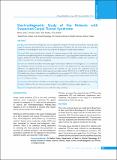Please use this identifier to cite or link to this item:
https://hdl.handle.net/20.500.14356/885Full metadata record
| DC Field | Value | Language |
|---|---|---|
| dc.contributor.author | Limbu, Rekha | - |
| dc.contributor.author | Limbu, Nirmala | - |
| dc.contributor.author | Khadka, Rita | - |
| dc.contributor.author | Subedi, Priza | - |
| dc.date.accessioned | 2023-04-03T08:03:31Z | - |
| dc.date.available | 2023-04-03T08:03:31Z | - |
| dc.date.issued | 2022 | - |
| dc.identifier.citation | LimbuR., LimbuN., KhadkaR., & SubediP. (2022). Electrodiagnostic Study of the Patients with Suspected Carpal Tunnel Syndrome. Journal of Nepal Health Research Council, 20(02), 321-325. https://doi.org/10.33314/jnhrc.v20i02.3890 | en_US |
| dc.identifier.issn | Print ISSN: 1727-5482; Online ISSN: 1999-6217 | - |
| dc.identifier.uri | http://103.69.126.140:8080/handle/20.500.14356/885 | - |
| dc.description.abstract | Abstract Background: Various electrodiagnostic tests are employed for diagnosis of carpal tunnel syndrome reporting wide range of sensitivity and specificity for each test in clinical practice. Therefore, the aim of our study is to assess the sensitivity of electrodiagnostic tests used in our set up for the diagnosis of carpal tunnel syndrome. Methods: This cross-sectional study consisted of 21 patients suspected with carpal tunnel syndrome who were referred to neurophysiology lab for electrodiagnostic evaluation and 21 age-group gender matched healthy controls. Digit 4, lumbrical versus ulnar interossei latencies and conventional nerve conduction variables were recorded. A p value of less than 0.05 was considered significant. Results: The sensitivity of median versus ulnar digit 4 sensory latency difference was the highest (72.72 %) whereas the conduction velocity of median nerve was the lowest (45.45%). The lumbrical versus ulnar interossei latency difference was significant between groups; however the sensitivity was only 51.52%. The conduction velocity of median nerve was relatively slower in the suspected cases than controls (49.67±13.75 vs. 60.90 ±6.70; p=0.007). The distal sensory latency of median nerve was significant between groups (3.47 ±0.58 vs. 2.16±0.25; p=0.03). The distal and proximal latencies of motor median nerve were significant between suspected cases and controls (4.70±1.82 vs. 2.75±0.38; p=<0.001). Conclusions: The sensitivity of median versus ulnar digit 4 sensory latency difference was the highest in our set up therefore, addition of this test with conventional method can be helpful in achieving a higher diagnosis rate. Keywords: Carpal tunnel syndrome; nerve conduction study; sensitivity | en_US |
| dc.language.iso | en | en_US |
| dc.publisher | Nepal Health Research Council | en_US |
| dc.relation.ispartofseries | April-June, 2022; | - |
| dc.subject | Carpal tunnel syndrome | en_US |
| dc.subject | Nerve conduction study | en_US |
| dc.subject | Sensitivity | en_US |
| dc.title | Electrodiagnostic Study of the Patients with Suspected Carpal Tunnel Syndrome | en_US |
| dc.type | Journal Article | en_US |
| Appears in Collections: | Vol 20 No 02 Issue 55 April-June, 2022 | |
Files in This Item:
| File | Description | Size | Format | |
|---|---|---|---|---|
| 3890-Manuscript-29674-2-10-20221103.pdf | Full Article. | 256.5 kB | Adobe PDF |  View/Open |
Items in DSpace are protected by copyright, with all rights reserved, unless otherwise indicated.
